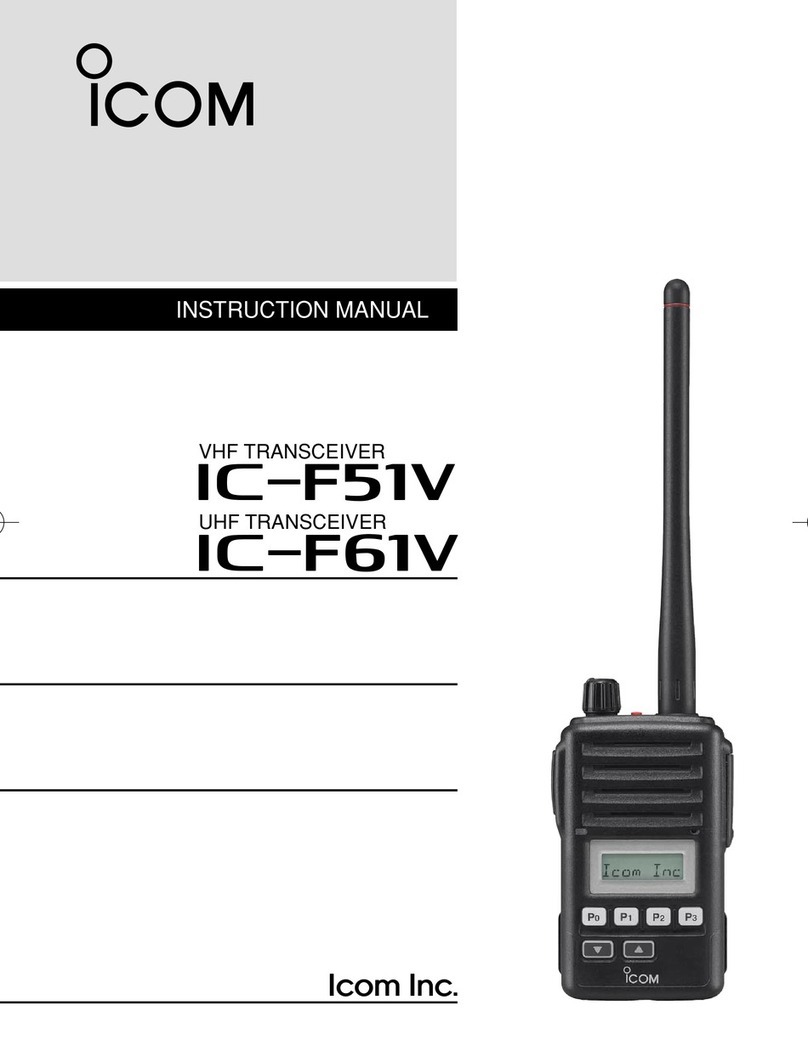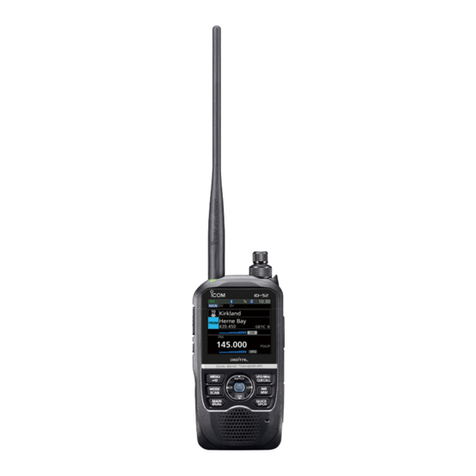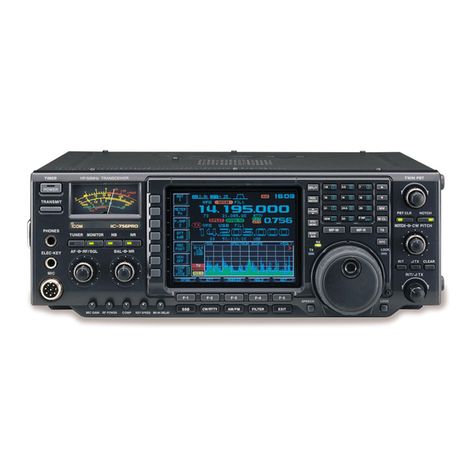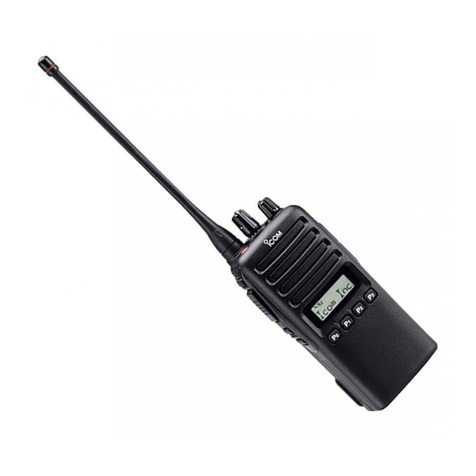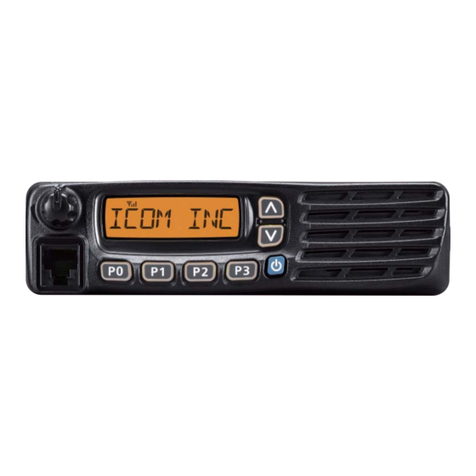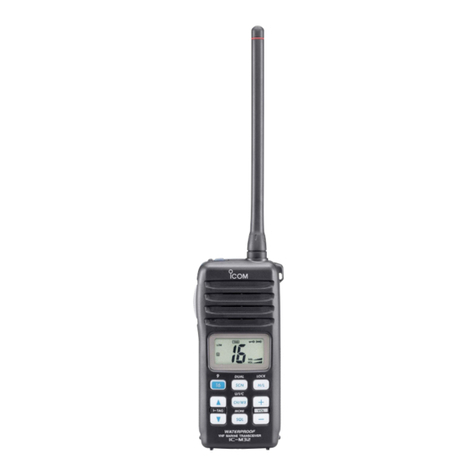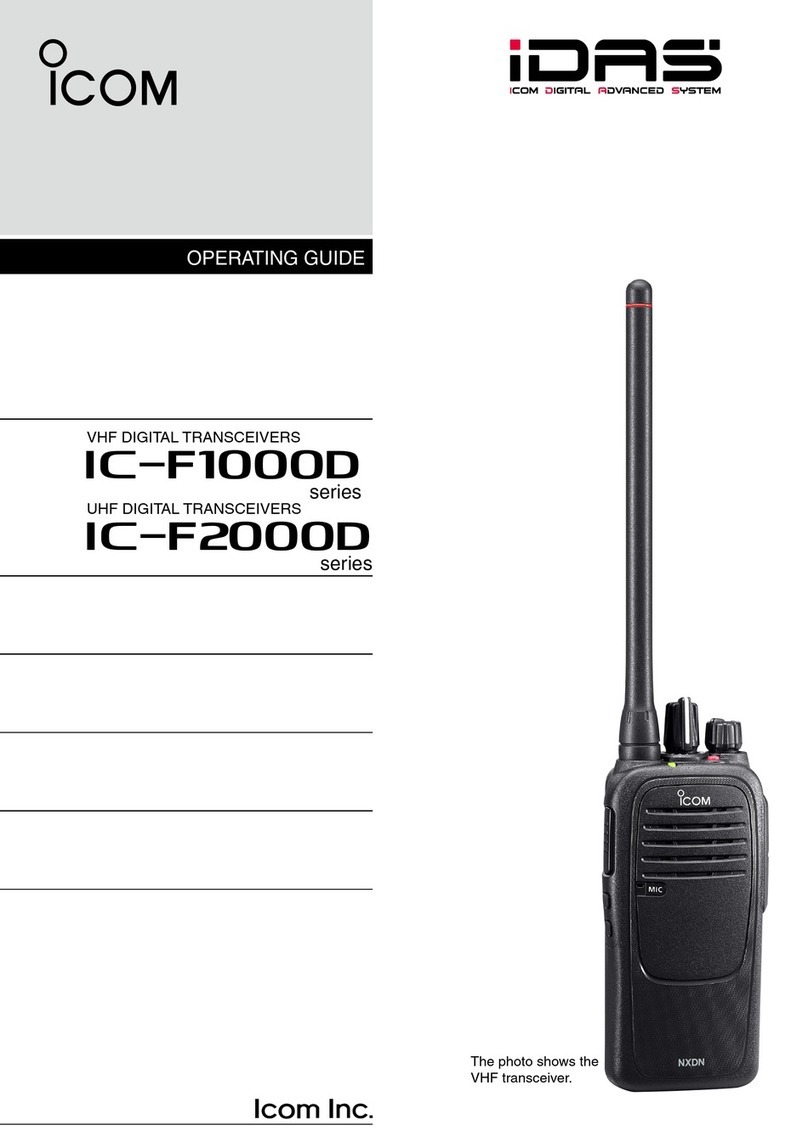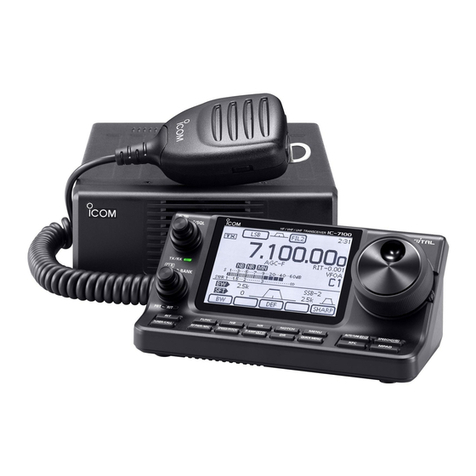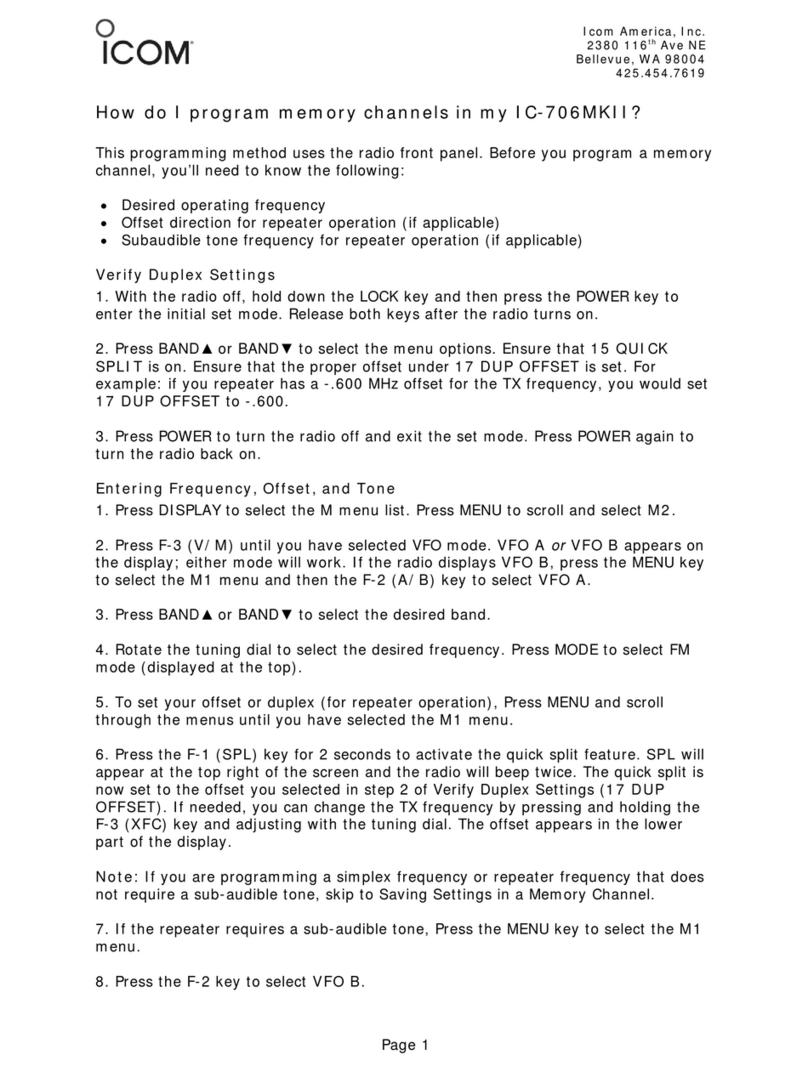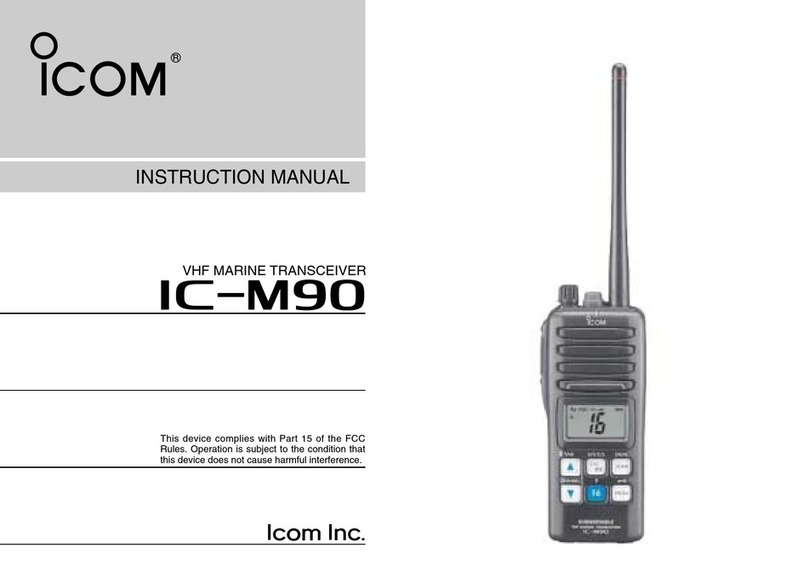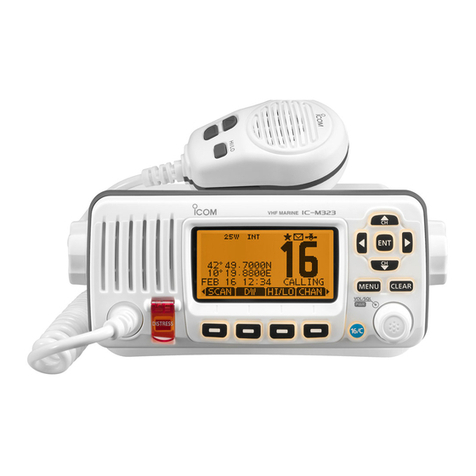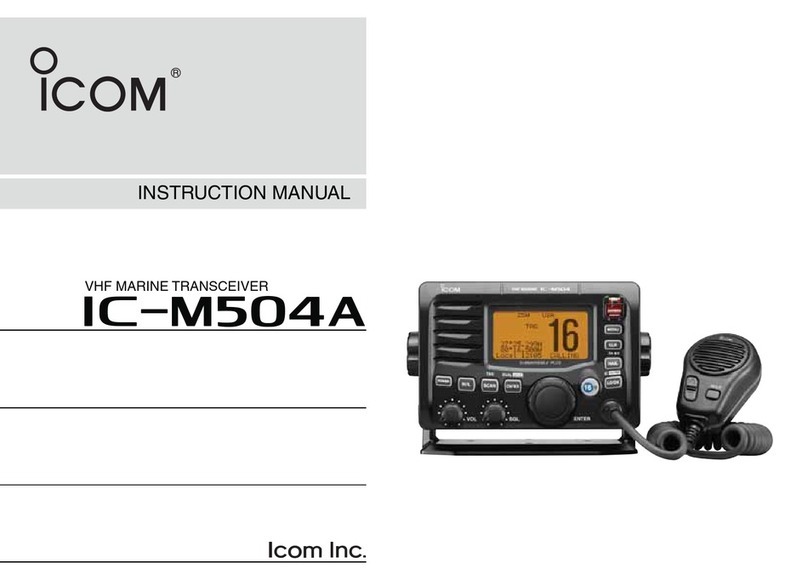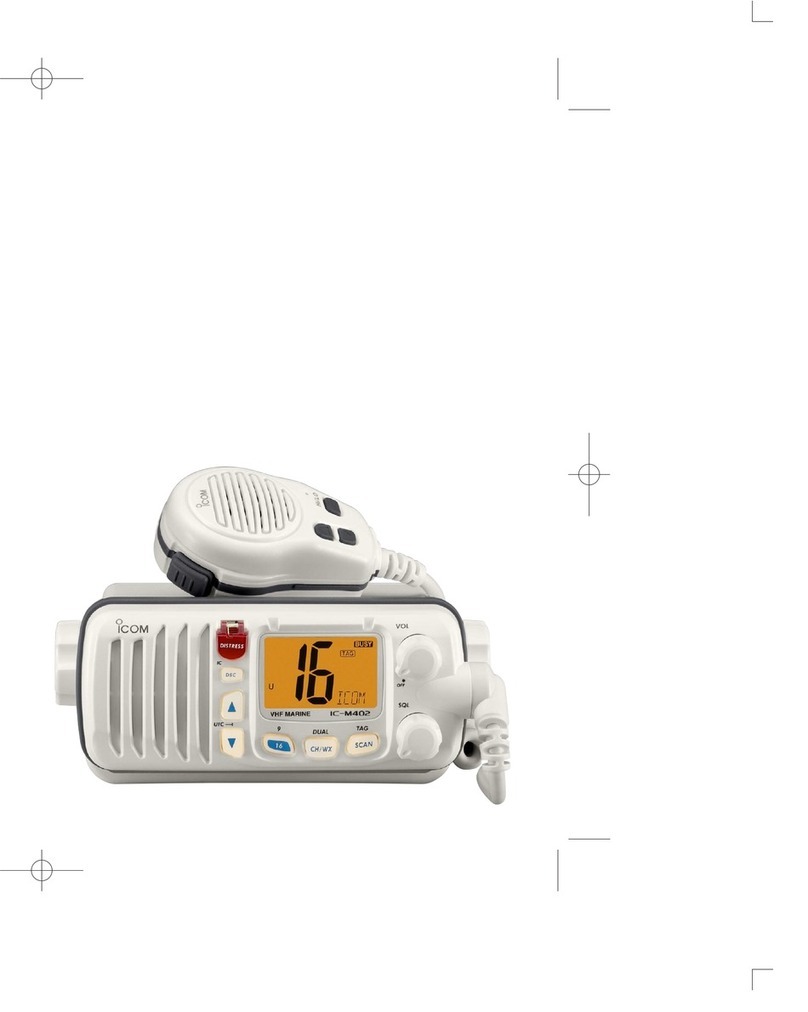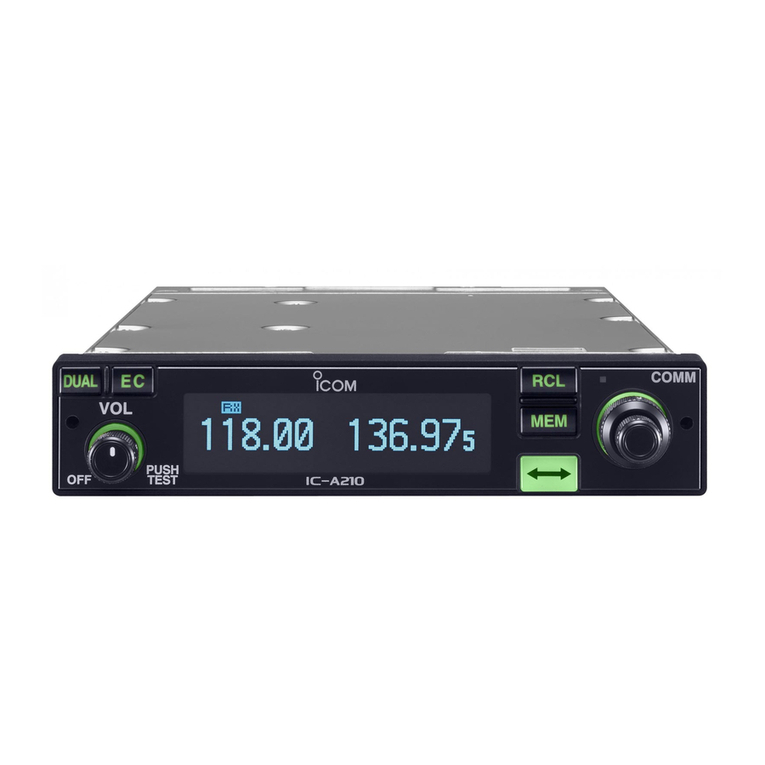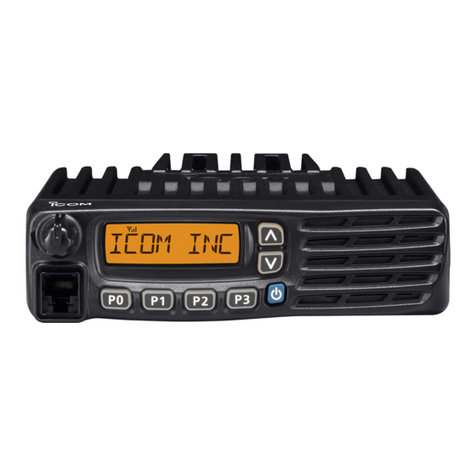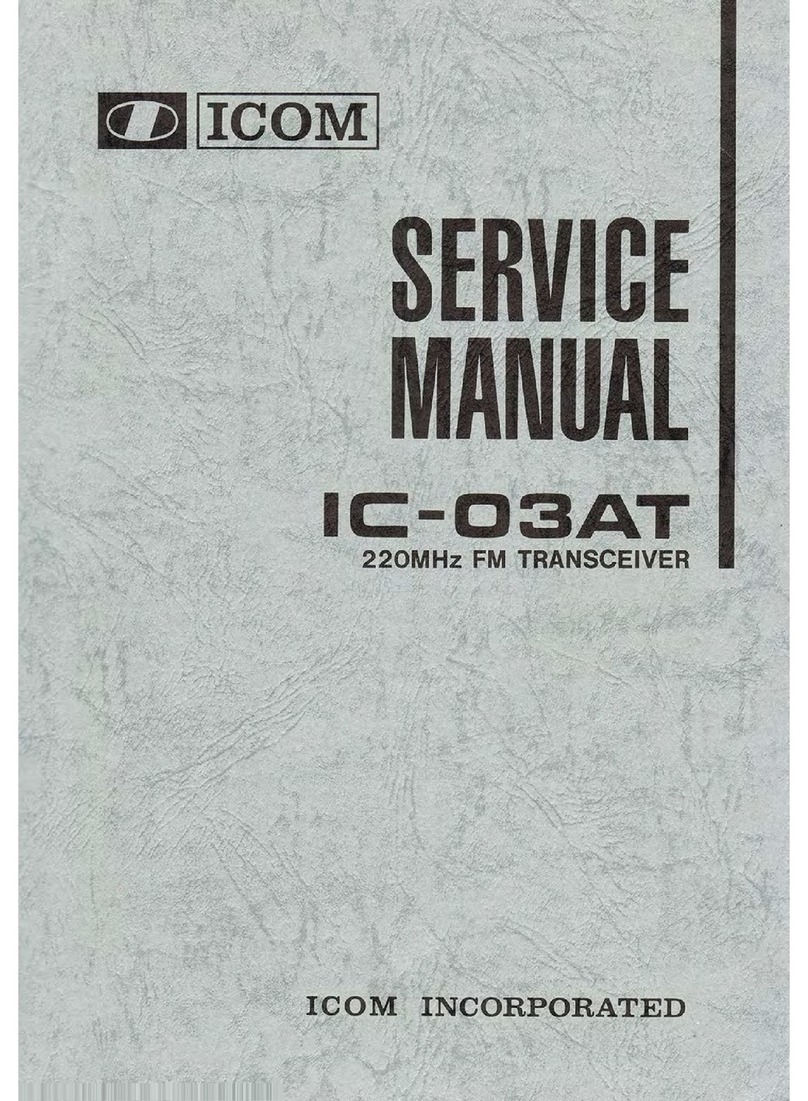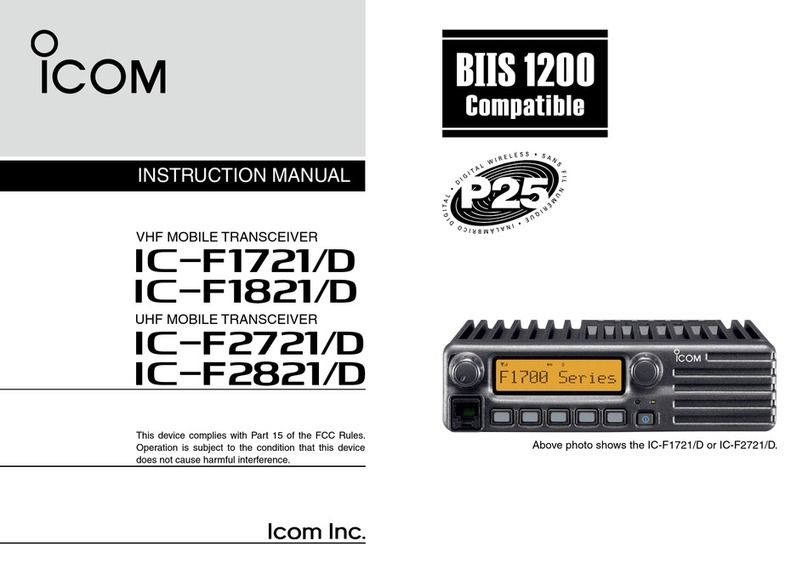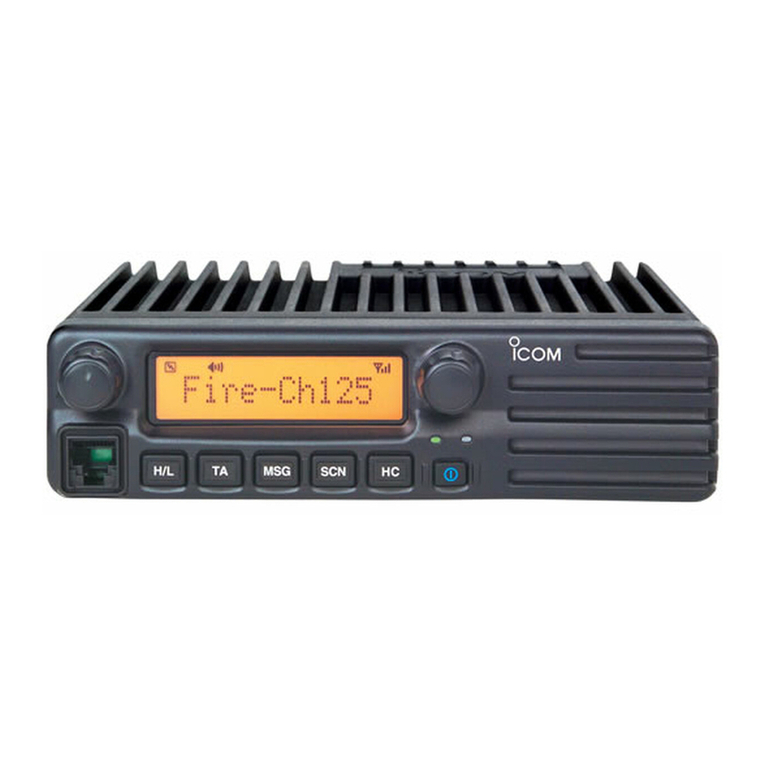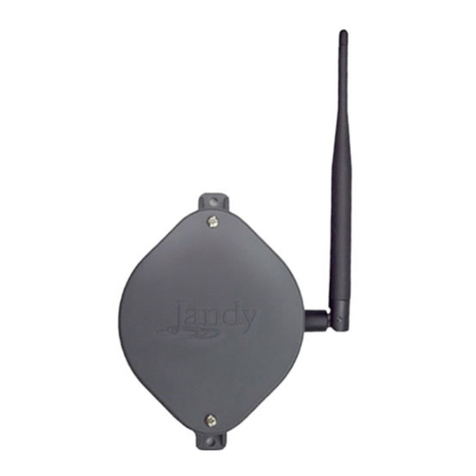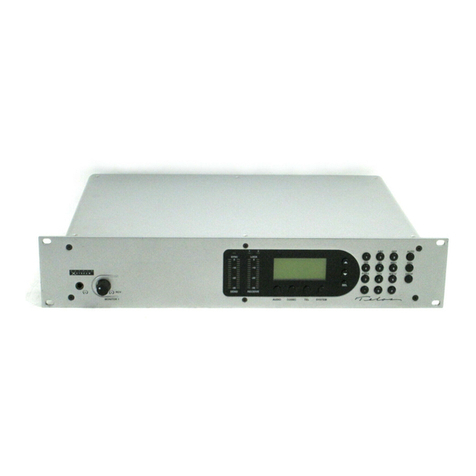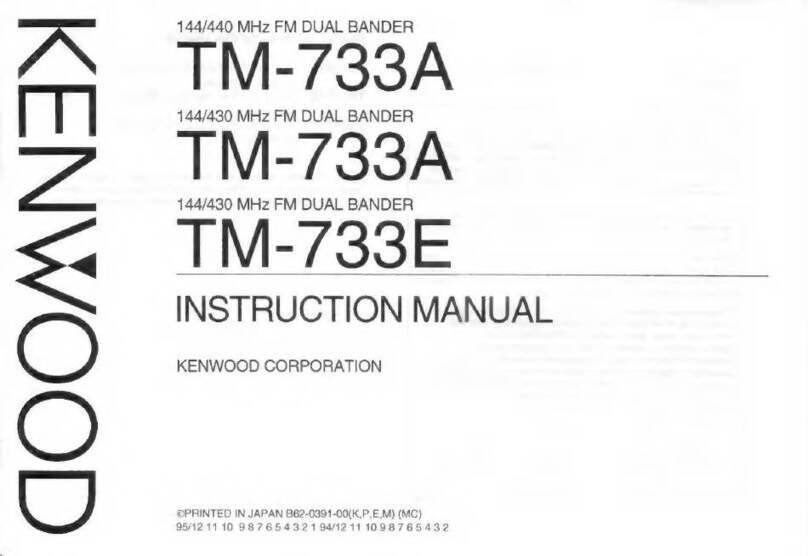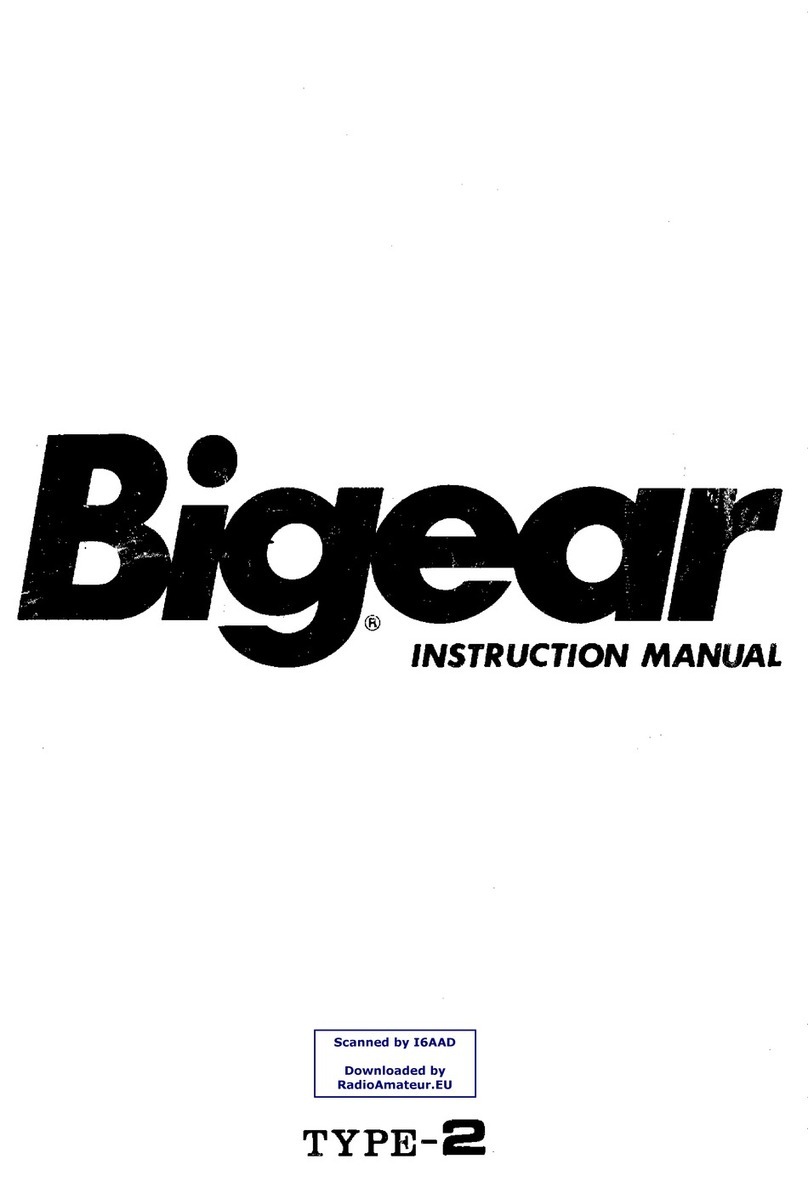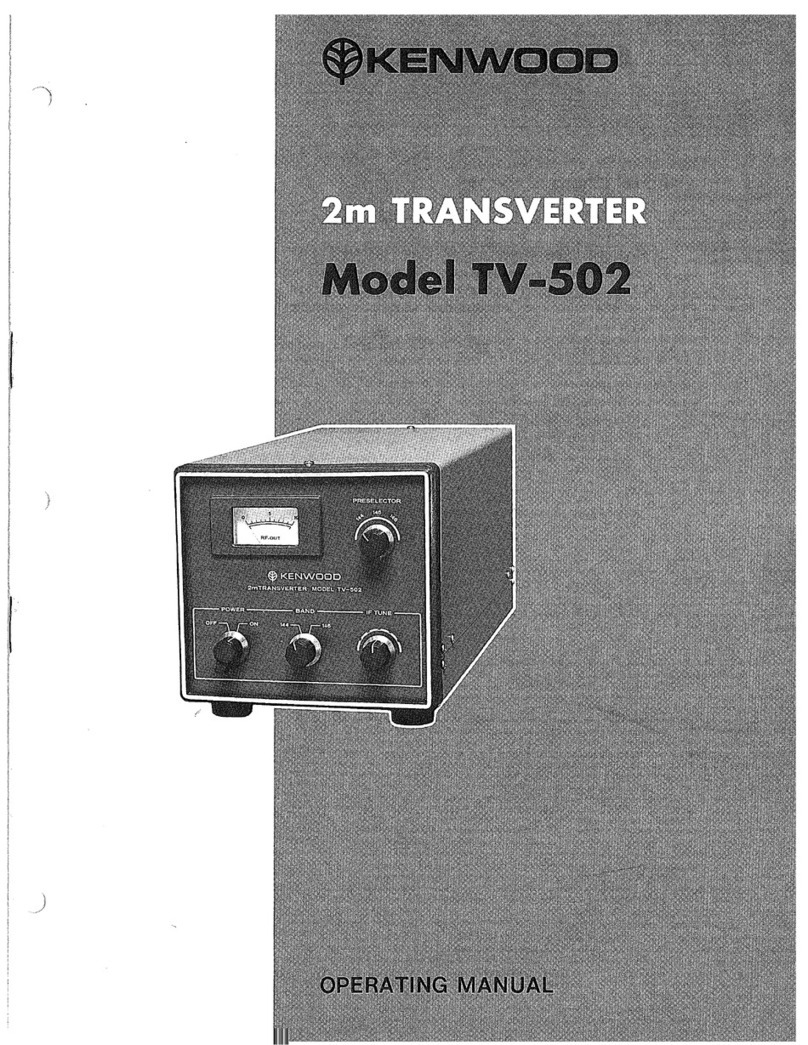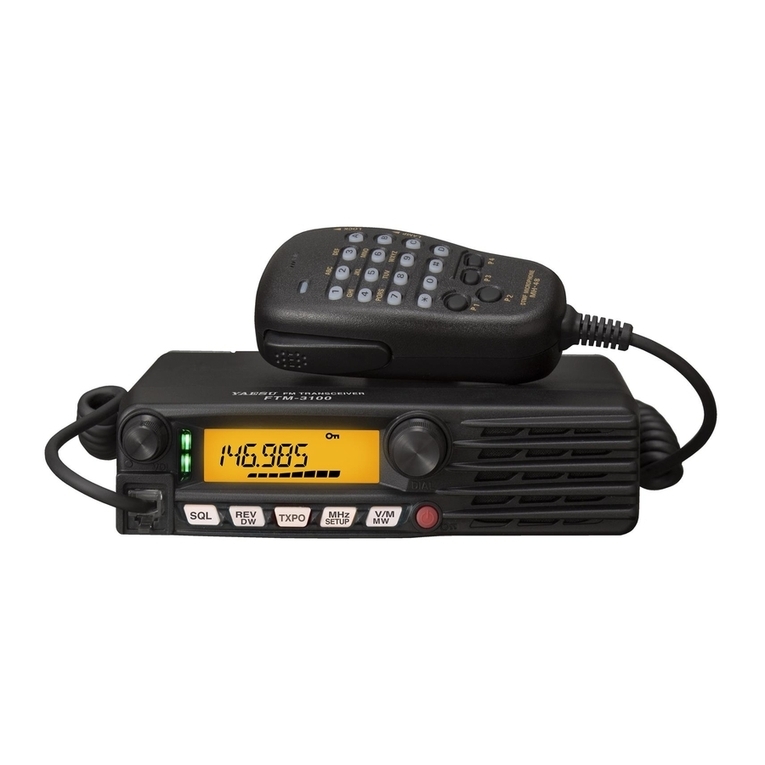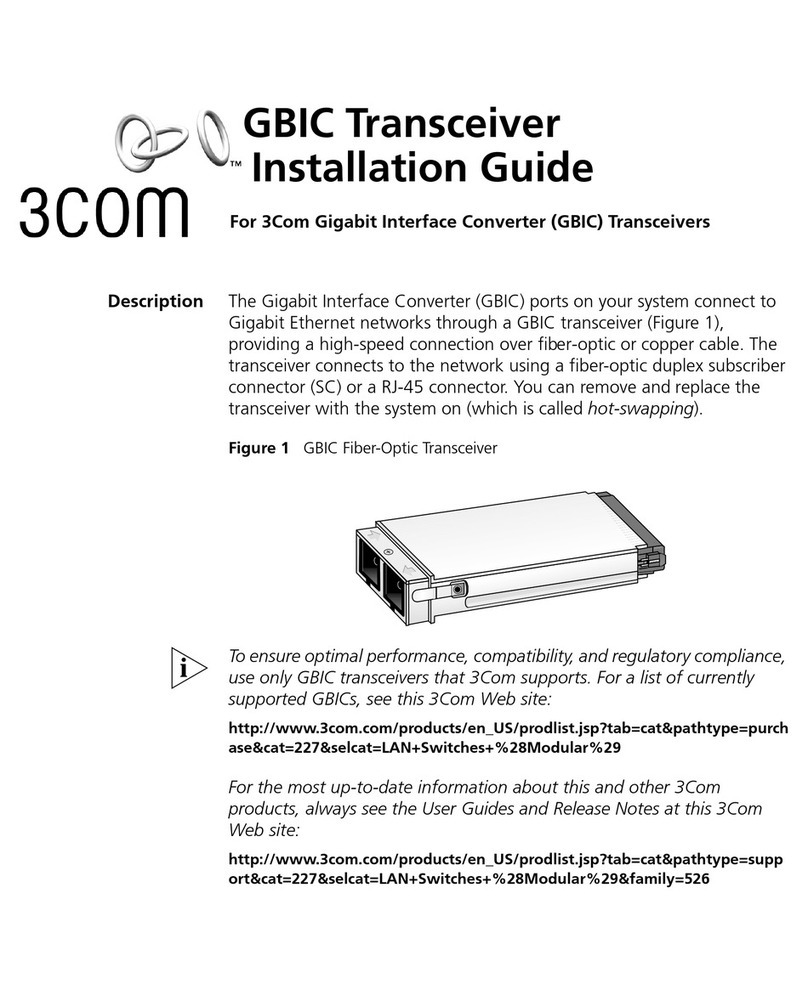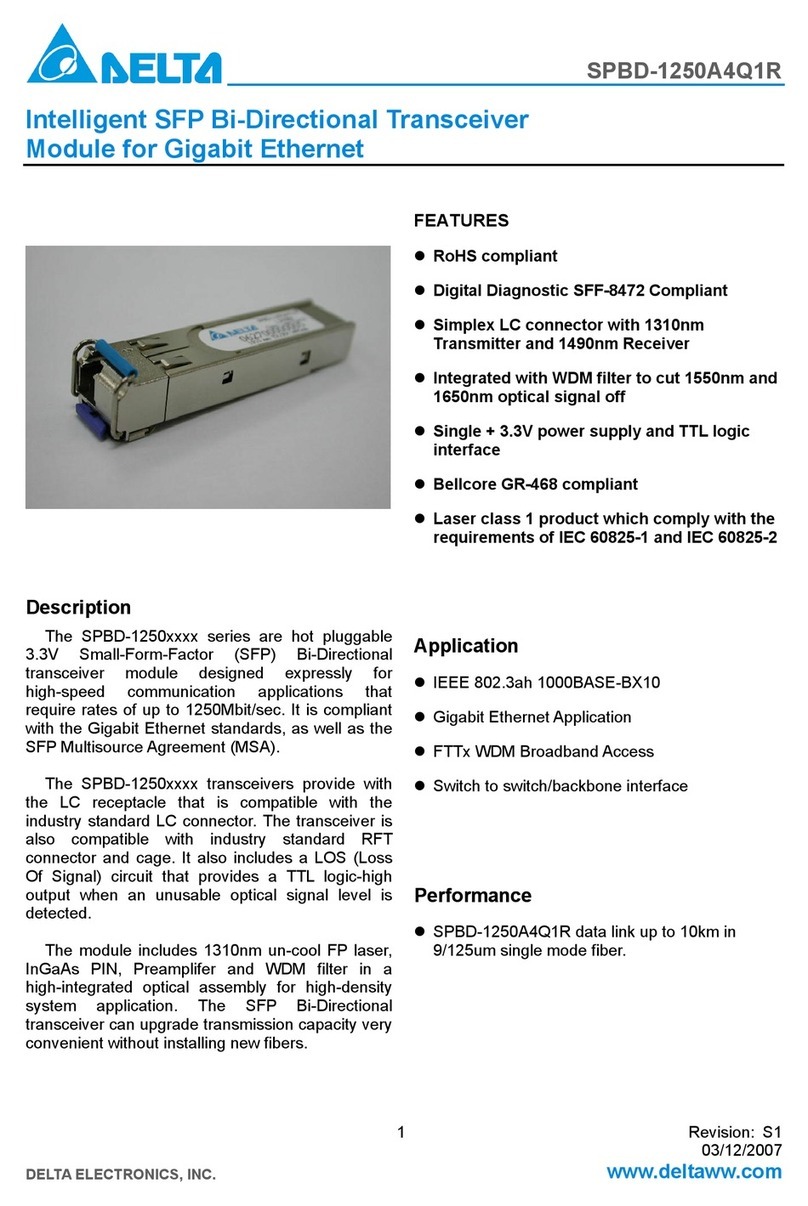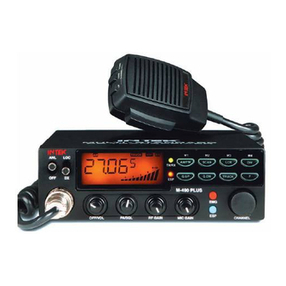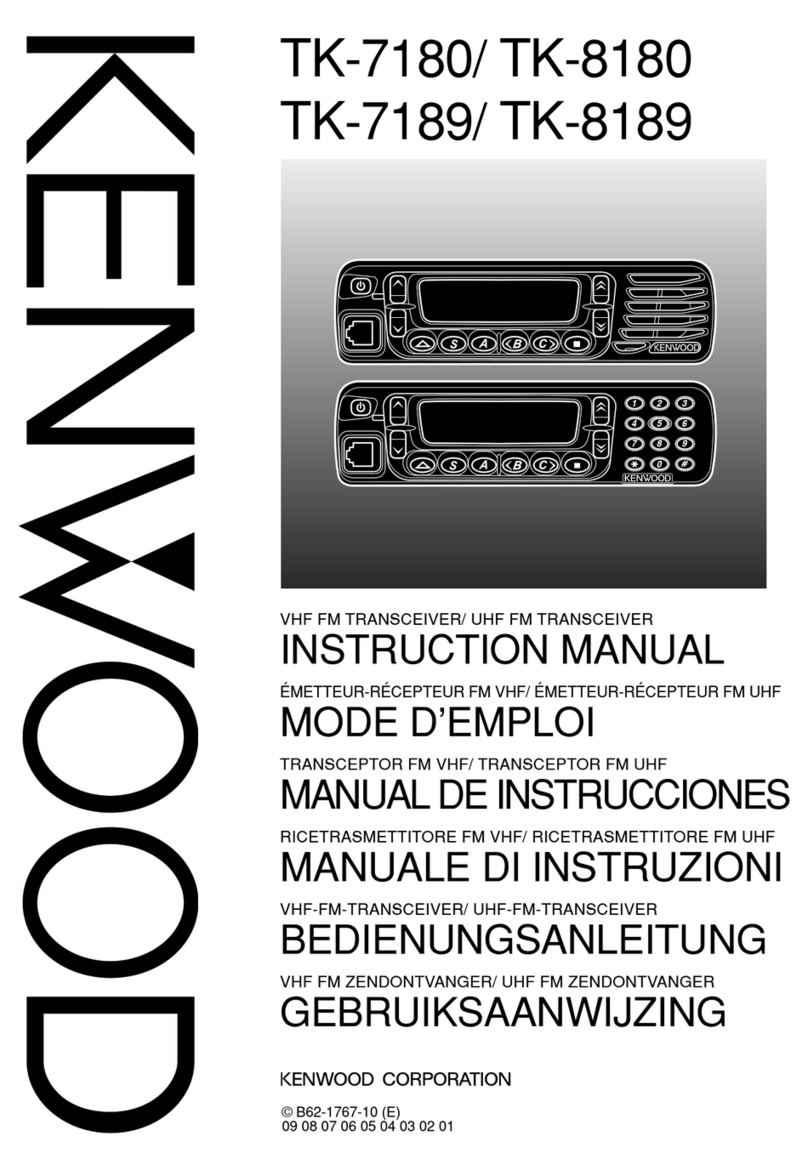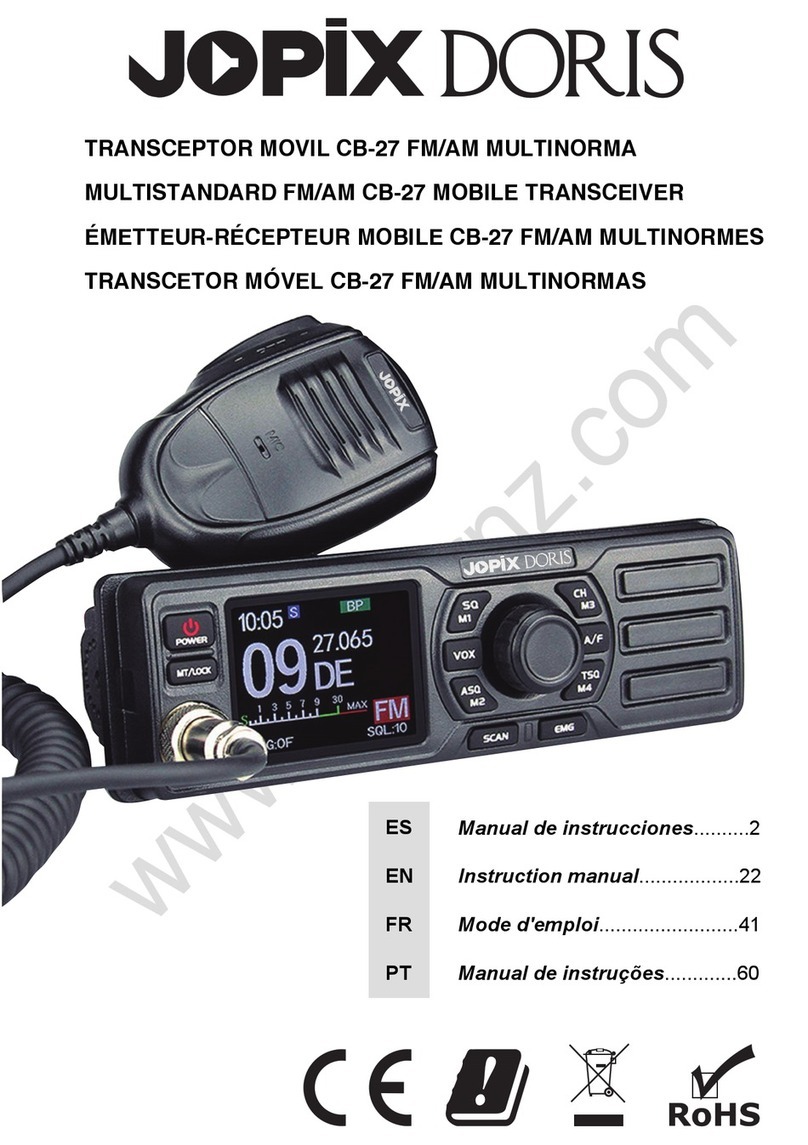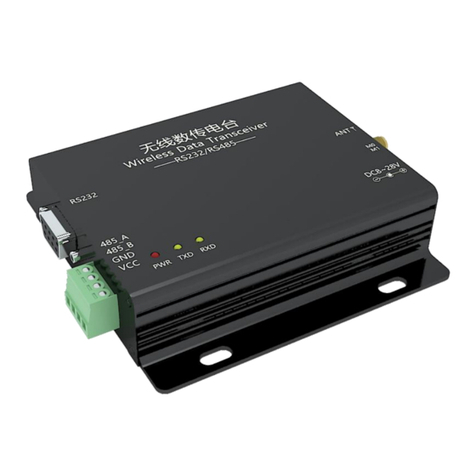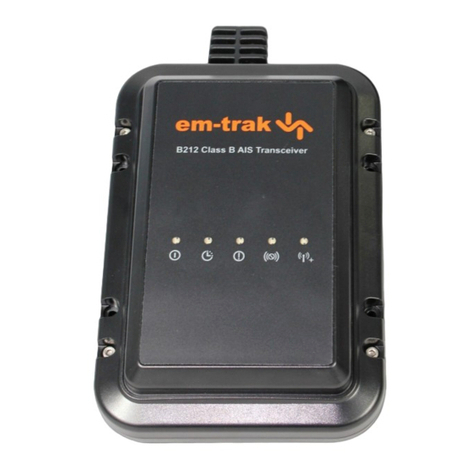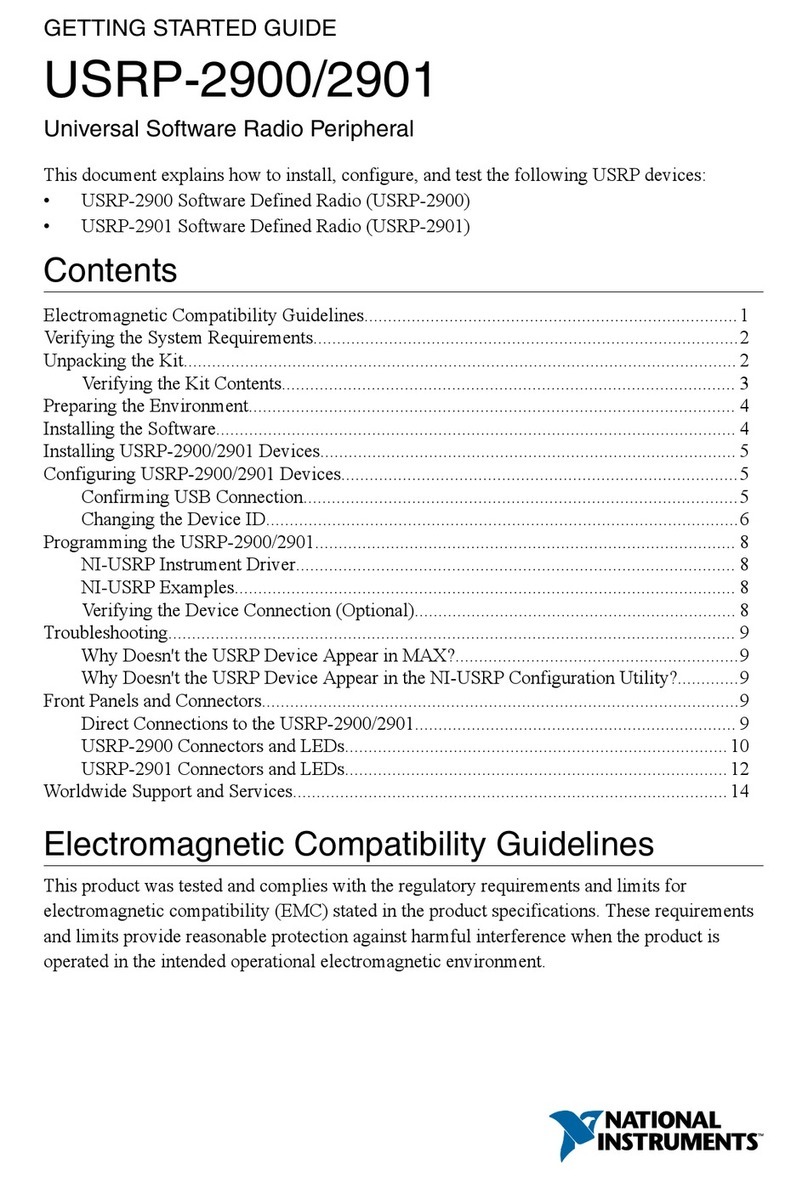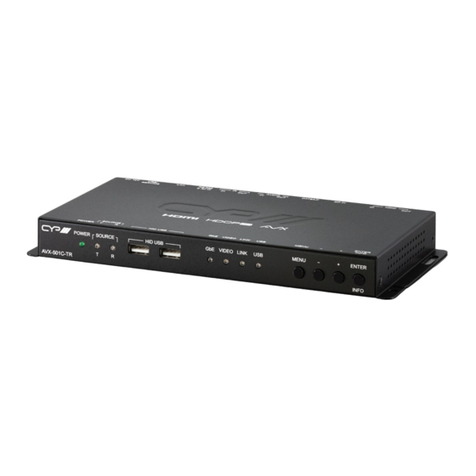Icom IC-H6 User manual

VHF
TRANSCEIVER
IC-H6
lcom
Inc.

TABLE
OF
CONTENTS
SECTION SPECIFICATIONS
........................................
. 1 - 1
SECTION 2
OPERATING
CONTROLS
..................................
. 2 - 1
"'
2
SECTION 3
CIRCUIT
DESCRIPTION
..................................
. 3 - 1
"'
4
3 - 1 RECEIVER
CIRCUITS
.................................
. 3 - 1
3-2
TRANSMITTER
CIRCUITS
.............................
.
3-2
3 - 3
PLL
CIRCUITS
.......................................
.
3-
2-
3
3 - 4
OTHER
CIRCUITRY
..................................
. 3 -
3-
4
SECTION 4
BLOCK
DIAGRAM
.......................................
. 4 - 1
SECTION 5 INSIDE VIEWS
..........................................
. 5 - 1
SECTION 6
MECHANICAL
PARTS
AND
DISASSEMBLY
.................
. 6 - 1
"'
5
6 - 1
DISASSEMBLY
OF
THE
CASES
.........................
. 6 - 1
6-2
DISASSEMBLY
OF
UNITS
.............................
.
6-
2-
3
6-3
PTT SPRING
ASSEMBLY
..............................
.
6-3
6
-4
TOP
PANEL
CONSTRUCTION
..........................
.
6-4
6 - 5
UNIT
BOTTOM
ASSEMBLY
............................
.
6-5
SECTION 7
MAINTENANCE
AND
ADJUSTMENT
.......................
. 7 - 1
"'
9
7 - 1
MEASURING
INSTRUMENTS
REQUIRED
FOR
ADJUSTMENT.
. . . . . . . . . . . . . . . . . . . . . . . . . . . . . . . . . . . . . . 7 - 1
7 - 2
PRELIMINARY
CHECKS................................
7-
2
7 - 3
PREPARATION
AND
PROCEDURE BEFORE
SERVICING
........................................
. 7 -
2-
3
7-4
HOWTOCHECK
.....................................
. 7 -
3-
5
7 - 5 BASIC
ALIGNMENT
PROCEDURE
.......................
.
7-6"'
9
SECTION 8
BOARD
LAYOUT
........................................
. 8 - 1
"'
3
SECTION 9
VOLTAGE
CHARTS
......................................
. 9 - 1
"'
4
SECTION 10
TROUBLESHOOTING
....................................
. 10 -
1"'
4
SECTION
11
IC
SPECIFICATIONS
.....................................
.
11
- 1
"'
3
SECTION 12 PARTS
LIST
............................................
. 12 - 1
"'
4

SECTION 1 SPECIFICATIONS
GENERAL
Number
of
Semiconductors
Number
of
Channels
Channel Spacing
Frequency
Stability
Usable Temperature
Antenna Impedance
Power Supply Requirement
Current Drain at 8.4V
Dimensions
Weight
RECEIVER
Frequency
Range
Receiving System
Modulation Acceptance
Intermediate Frequency
Sensitivity
Squelch Sensitivity
Spurious
Response
Rejection Ratio
Selectivity
Intermodulation Rejection Ratio
Audio
Output
Power
Audio
Output
Impedance
TRANSMITTER
Frequency
Range
Output
Power
Emission Mode
Modulation System
Max. Frequency Deviation
Spurious Emission
Microphone
Transistors
FET
IC
43
3
5
Diodes 15 (not including diodes on the
matrix
board)
6 programmable channels (Transmit
and
Receive frequencies
are
pro-
grammable independently
for
each
channel)
Operation; Simplex, Semi-duplex
25KHz
(5KHz increments frequencies
are
programmable)
0.001 Percent
-20
Degrees
C
to
60
Degrees
C
(-4
Degrees
F
to
140
Degrees
F)
50 ohms unbalanced
DC
8.4
V;
with
attendant power pack IC-CM3,
DC
7
to
12V negative
ground
is
acceptable
Transmitting
At
2.5 watts
output
Approx.
700mA
Receiving
At
max audio
output
Approx.
130mA
Squelched Approx.
25mA
116.5mm(H) x 65mm(W) x 45mm (D)
without
power pack
Attendant
power pack, IC-CM3:
49mm(H)
x 65mm(W) x
35mm(D)
510g including power pack, IC-CM3,
and
flexible antenna
Specified 2MHz segment (5MHz
with
reduced specification)
within;
150.005 ~ 155.000MHz
155.005 ~ 160.000MHz
160.005
~
165.000MHz
165.000 ~ 170.000MHz
Double-conversion superheterodyne
16F3 ±7.5KHz (F3E 16KO)
1st: 16.9MHz
2nd:
455KHz
Less
than 0.5µV
for
20dB noise quieting
Less
than 0.4µV
for
12dB
SI
NAD
Less
than 0.4µV
More than 60dB
More than 65dB at adjacent channel
More than 60dB
More than 300mW at
10%
distortion
8 ohms
Specified 2MHz segment (5MHz
with
reduced specification)
2.5 Watts
(4
watts
with
10.BV battery pack IC-CM5)
16F3 (F3E 16KO)
Variable reactance frequency modulation
±5KHz
More than 60dB below carrier
Built-in electret condenser microphone
Optional speaker-microphone (IC-CM9)
can
be
used
1 - 1

SECTION 2 OPERATING CONTROLS
TOP
PANEL
@TRANSMIT/BATTERY
INDICATOR----~
...-----------·@CHANNEL
SELECT SWITCH
d)ANTENNA
CONNECTOR----
(j)
EXTERNAL
MIC
JACK-----'-
@EXTERNAL
SPEAKER
JACK
FRONT PANEL
@PUSH-TO-
TALK
(PTT)-----4
SWITCH
SPEAKER
MICROPHONE
2-1
~-----@SQUELCH
CONTROL
'--------@VOLUME
CONTROL
and
POWER SWITCH
REAR PANEL
l
:1.
@CHARGER
CONNECTOR
@BATTERY
CHARGE
INDICATOR

(])
ANTENNA CONNECTOR
Connect
the
supplied flexible antenna. An external antenna can be used, using a
BNC
connector.
®
TRANSMIT/BATTERY
INDICATOR
Illuminates
in
the transmit mode. Also indicates the battery condition; during transmission. The
voltage
of
Nickel-Cadmium batteries drops rapidly just before they are exhausted,
so
when this
indicator goes
out,
be sure
to
immediately stop using it, and charge the batteries again.
@ CHANNEL SELECT SWITCH
Selects one
of
the
programmed channels.
@)
SQUELCH CONTROL
Sets
the
squelch threshold level. To turn
OFF
the squelch function, rotate this control completely
counterclockwise. To set the threshold
level
higher, rotate
the
control clockwise.
@ VOLUME CONTROL
and
POWER
SWITCH
When the control
is
turned completely counterclockwise,
the
power
is
OFF.
By
turning
the
control
clockwise beyond
the
"click",
the
unit
is
turned
ON
and
the
audio
level
increases by further rotat-
ing
it clockwise.
@
EXTERNAL
SPEAKER JACK
When
an
external speaker (or
an
earphone)
is
used, connect it
to
this jack.
Use
a speaker with an
impedance of 8 ohms. When
the
external speaker
is
connected
the
built-in speaker does
not
function.
(J)
EXTERNAL
MIC JACK
When an external microphone
is
used, connect it
to
this jack. See
the
schematic for
the
proper
hookup. When the external microphone
is
connected the built-in microphone does
not
function.
The
IC-CM9
optional speaker-microphone can also be used.
Electret condenser microphone Dynamic microphone
Microphone
Microphone
0
[_______..______!
~.
R
R=20-30K.11 PTT SWITCH
PTT SWITCH
@
PUSH
TO
TALK
(PTT) SWITCH
For transmission, press this switch and talk into
the
microphone with normal voice. The internal
microphone
is
of
the electret-condenser
type
and provides good pickup for
all
voice levels.
@ CHARGER CONNECTOR
Connects
to
the
output
plug
of
the
wall charger CM-25U/E
or
other
12V
DC
power source.
@ BATTERY CHARGE INDICATOR
Lights during battery charging.
2-2

SECTION
3 CIRCUIT DESCRIPTION
3 - 1 RECEIVER CIRCUITS
3 - 1 - 1 ANTENNA SWITCHING CIRCUIT
Signals from the antenna connector are fed
to
the antenna switching circuit through Chebyshev low-pass
filter consisting
of
L229, L230, C295, C297 and C298 in the PLL board.
The antenna switching circuit employs a quater wave switching circuit.
In
the
receive mode, switching diodes,
0216
and
0217
are turned OFF, and
they
make isolation against
the transmitter circuit and matching circuit, and the incoming signals are fed
to
the
RF
amplifier.
3 - 1 • 2
RF
AMPLIFIER
AND
FIRST MIXER
The signals from the switching circuit are fed
to
the
cascode amplifier
0101
and
0102.
The amplified signals are fed
to
the gate of the first mixer
0103
through the band-pass filter L102 -
L104, which reduces interference and intermodulation from
out
of the band signals.
To the source of
0103,
a 140MHz signal*
is
supplied from the PLL circuit
to
convert the RF signals into
16.9MHz first
IF
signals. (*This frequency differs depending on the version, and it can
be
calculated by
formula; "Receive frequency" -16.9MHz.)
The first
IF
signals are taken from the drain
of
0103
and fed
to
the
IF
circuit.
3 -
1·3
IF
CIRCUIT
The first
IF
signals from
0103
are fed
to
the
matched pair crystal filter F1101, then
IF
amplifiers
0104
and
0105.
The amplified signals are fed
to
IC101. IC101
is
composed
of
the second localoscillator, second mixer,
limiter amplifier, quadrature detector and active filter circuits.
The second local oscillator oscillates 16.445MHz with X101, and
is
fed
to
the second mixer with thefirst
IF
signals
to
convert into 455KHz second
IF
signals. The second
IF
signals are put
out
from
Pin
3, and
fed
to
external ceramic filter F1102 which has excellent selectivity, then fed
to
IC101
(Pin
5) again
to
amplify and detect.
The detected AF signals are put
out
from
Pin
9.
3 - 1 - 4
AF
AND
SQUELCH CIRCUITS
The detected AF signals are
put
6dB/Octave de-emphasis by integral circuit consisting of R117 and Cl26,
and fed
to
AF power amplifier IC102 through
the
VOLUME control R1,
to
obtain enough power
to
drive
the
speaker.
Noise components put
out
from
Pin
9 of
IC101
are fed
to
IC101
(Pin
10) again through the SQUELCH
control R2, which controls the squelch threshold level, filtered about 20KHz signal {noise) and
put
out
from Pin 11.
This signal (noise)
is
rectified by
0113,
integrated by R135, R136 and C136, and turns
0114
ON
and
turns OFF
the
regulator for AF power amplifier consisting of
0103,
0115
and
0116.
This reduces the current drain of the set,
in
the standby condition.
When
a signal
is
received, noise
is
suppressed by
the
signal and turns
0114
OFF and
the
regulator
is
turned
ON
and supplies regulated
voltage
to
the AF power amplifier, and incoming signal can be heard from
the
speaker.
In
the transmit mode, a voltage
is
applied
to
0114
and turns it ON, and turns the regulator OFF
the
same
as
in
the standby condition.
3-1

3 - 2 TRANSMITTER CIRCUITS
3-
2 - 1 MIC AMPLIFIER CIRCUIT
Audio signals from
the
microphone are fed
to
the
limiter amplifier, consisting
of
0125-
0128,
which
has 6dB/Octave response between 300Hz and 3KHz.
The
output
of
the
limiter amplifier
is
similar
to
rectangular waves and includes harmonics.
These harmonics are eliminated by
the
low-pass filter
0129,
which cuts 3KHz
or
higher.
Filtered signals are fed
to
the
VCO
in
the
PLL board
to
make modulation.
3-
2 · 2 MULTIPLIER AND DRIVER CIRCUITS
The
VCO
oscillates a half
of
a transmitting frequency,
thus
the
multiplier
0208
and
0209,
multiplies it
two
times
to
obtain 156MHz* transmitting frequency.
This 156MHz* signal
is
fed
to
amplifiers
0211and0212
through band-pass filter L219, L220 and L221,
L222
to
obtain 200 milliwatts pure 156MHz* signal. While switching from receive
to
transmit,
0210
is
turned
ON
by the charged voltage of C269, until the charged voltage has been discharged, and this
function cuts the bias voltage
of
0211,...,
0213.
This prevents transmission
of
unwanted signals.
(*This frequency differs depending
on
the
version.)
3 · 2 · 3
POWER
AMPLIFIER CIRCUIT
The
output
signals from
0212
is
fed
to
the
power amplifier
0213,
and amplified
to
2.5 watts.
In
the transmit mode,
0216
and
0217
are turned ON, and
0217
makes L228 have high-impedance and
0216
feeds
the
signals
to
the antenna through the low-pass filter.
3 · 3 PLL CIRCUITS
3 · 3 - 1 LOCAL OSCILLATOR CIRCUIT
The crystal oscillator
0206
oscillates 35.77625MHz* with X202 for receive, 40.00125MHz* with X203
for transmit, and
the
signal
at
two
times this frequency
is
taken from
the
collector
of
0207,
and fed
to
the
mixer of the PLL circuit.
(*These frequencies differ depending on the version.)
In
the
receive mode, R+6V
is
applied
to
0210
through R223, L211 and R227, and
0210
is
turned
ON
and selects X202.
In
the
transmit mode, T+6V
is
applied
to
0211
through R224, L212 and R228, and 0211
is
turned
ON
and selects X203.
3 - 3 · 2 MIXER,
LOW-PASS
FILTER AND AMPLIFIER CIRCUITS
The
output
signals from
the
local oscillator circuit and the VCO signals fed through buffer amplifiers
0202
and
0203
are mixed by
the
mixer
0204.
The
output
signals are fed
to
the low-pass filter
to
filter
out
only the signals below 7MHz, then fed
to
0205
to
be
amplified
to
proper drive
level
(more than
3Vp-p)
of
the
programmable divider IC201.
3 · 3 · 3 PROGRAMMABLE DIVIDER CIRCUIT
The input signals
at
Pin 2
of
IC201 are divided by
the
BCD
input signals from the matrix board
at
Pin
3-14.
The programmable divider
is
also called the 1/N counter and the
BCD
value
is
N.
The relationship between the operating frequency and
the
divide number N
is:
N (divide number
of
programmable divider) =
Receive (or Transmit) Frequency
(MHz)
-Local Osc Frequency
(MHz)
_
1000
0.005
3-2

3-
3 - 4 REFERENCE FREQUENCY GENERATOR CIRCUIT
Reference frequency generator IC203 consists of a crystal oscillator and a highspeed divider. X201 oscil-
lates
at
5.12MHz, which
is
divided by 2048. The 2.5KHz reference frequency
is
fed
to
phase
detector
IC202. This 2.5KHz reference frequency decides
the
variation step of the PLL
output
frequency.
3 - 3 - 5 PHASE DETECTOR
AND
LOOP
FILTER
CIRCUITS
Digital phase detector, IC202, detects
the
phase difference of
the
pulse signals
of
the
2.5KHz reference
frequency and
the
output
signal
of
the
programmable divider, and proportionately puts
out
pulse signals
at
Pin
3,
which becomes high impedance when
the
PLL
is
locked.
Pin 4
is
for detecting
the
lock failures and changes
to
ground level according
to
the
phase difference of
the
two
pulse signals. When
the
lock fails,
the
pulse signal from Pin 4
is
integrated by R202 and C215.
When
the
integrated voltage exceeds
the
junction voltage
of
0214's
base,
0214
is
turned
ON
and
then
0107
in
the
MAIN
boards
is
turned
ON.
The collector
of
0107
is
connected
to
the
base of
0108,
so
the
base voltage
of
0108
becomes ground
level, and
0108
and
0106
are
shut
off
to
prevent transmitting unwanted signals.
The
loop filter, consisting
of
R204, R205, R206, C213 and C214, converts
the
pulse signal from Pin 3
into a
DC
voltage and decides
the
response time
of
the
whole loop.
The
output
signals are fed
to
tuning diode D203
of
the
VCO circuit
as
the control voltage for
the
VCO
frequency set.
3-
3 - 6 VCO CIRCUIT
The VCO (Voltage-Controlled Oscilator)
is
a Colpitts circuit using
0201,
and oscillates
in
70 -80MHz
range.
The oscillator frequency
is
controlled by a
DC
voltage which
is
supplied from
the
loop filter
to
varactor
diode D203.
In
the
receive mode, R+6V
is
applied
to
D204's anode through L201, and D204
is
turned
ON
and shunts
C220. Thus
the
free-run frequency
of
the
VCO
is
lowered.
In
the
transmit mode, T+6V
is
applied
to
D204's
cathode
through D205 and L202, D204
is
turned
OFF,
and C220
is
inserted
in
the
oscillator circuit in series. Thus
the
free-run frequency of
the
VCO
is
increased.
In
the
same time,
the
VCO signal
is
frequency modulated by
the
audio signals from
the
microphone which are applied
to
the
gate
of
0201
and varies
0201
's mutual conductance.
3 -4 OTHER CIRCUITRY
3 - 4 - 1
POWER
SUPPLY CIRCUIT
The
regulated 6V
is
supplied
to
the
main circuits, so
that
the
set operates under a stable condition with
as low power voltage
as
possible.
The power supply voltage
is
fed
to
the
AF power amplifier through
the
squelch switching circuit and
to
the
6V regulator consisting
of
0117
-
0120
and zener diode D104. This regulated 6V
is
supplied
to
the
PLL circuit.
In
the
transmit mode,
the
base of
0123
is
grounded through R155,
the
microphone and
the
PTT switch,
and
0123
is
turned
ON. Thus
0106
and
0108
are
turned
ON
and T+6V
is
actuated, and supplied
to
the
transmitter circuit.
At
the
same time, T+6V turns
0112
ON, and
the
power supply voltage
is
applied
to
the
MIC
amplifier circuit through
0112.
In
the
receive mode,
0123
is
turned
OFF
and
the
bias voltage
of
0109
ON. Thus
the
R+6V
is
actuated
and supplied
to
the
PLL board
to
switch
the
local oscillator crystal and
the
driver transistors
of
the
transmitter
circuit.
At
the
same time, R+6V turns
ON
the
voltage boost circuit consisting
of
0110
and
0111,
and +6V
is
supplied
to
the
receiver circuit.
3-3

3-
4-
2 LED
INDICATOR
CIRCUIT
This LED
is
lit
in the transmit mode,
but
when the power supply voltage becomes
less
than 7V,
it
will
not
be
lit.
The power supply voltage
is
divided
by
R148 and R149, and applied
to
the
base
of
0121.
The emitter
of
0121
is
connected
to
the regulated
6V
source.
When
the power supply voltage
is
more than 7V,
0121
is
turned OFF,
0122
is
turned ON and
T+6V
is
applied
to
the LED through
0122
and R150, and
the LED
is
lit.
3-
4-
3 DIODE
MATRIX
BOARD
The
set
incorporates a diode
matrix
board
to
determine its operation frequencies, and six channels
each
can
be
programmed
into
the board
for
transmit and receive.
+6V
is
applied
to
each
channel line, one
of
receive channels 1 - 6 and transmit channel 1 - 6, through
the channel select switch, and
it
is
converted
to
BCD
codes
by diodes programmed
into
the board, then
fed
to
IC201
to
determine
an
operation frequency.
When duplex transmit
function
is
required, calculate
each
N value
for
transmit frequency and receive
frequency and program diodes
into
the board independently.
The receive
only
function
is
provided
for
channel 2 - Channel 6 by inserting a diode
into
the receive
only
line.
At
this time, a voltage
is
applied
to
the
base
of
0107
on the
MAIN
board through R404, and
it
turns
0107
ON and
0106
OFF. Thus, the
set
does
not
turn
to
the transmit mode,
even
if
the PTT
switch
is
depressed.
Crystal Frequency Chart
Operating Frequency
Range
Crystal Frequency (MHz) Local Oscillator
X202
(Receive)
X203
(Transmit) Frequency (MHz)
150.005 -155.000MHz 32.02625 36.25125 145.005
155.005 -160.000MHz 33.27625 37.50125 150.005
160.005-
165.000MHz 34.52625 38.75125 155.005
165.005 -170.000M
Hz
35.77625 40.00125 160.005
NOTE: The local oscillator frequency
for
calculation N value
is
the
four
times
of
the crystal frequency.
3-4

""'
I
16.9MHz
455KHz
RF
Amp
' Ceramic Noise Squelch
1st Mixer Crystal 1st
IF
Amp
,.
0101
r-+
,.
Filter
~
Filter
Detector
~
Control
2SC2026
0103
F1101
0104,
0105
--
0113
r
,___
F1102
0114,
0115
0102
2SK192 16M15B2 2SC2668 x 2
2SC2668
CFU455E2
2SA1048 2SC2458 x 2
f
~VCC
~
~
I v I Squelch [
Indicator
Regulator
T/R
Switch
~
-.j
2nd
Mixer
2nd
~
Noise
Amp~
Control
0117
2SK192
0106,
109,
111
~R6V
IF
Amp
re--
0118
2SB562 rl>
116,112
t
AF
Powoc
-.aj
0121,
0122
0119,
0120
2SA1048 x 2 2SC2458 x 2
4J
r<rcJ
~
6V
LED
Power
Switch
x2
Multiplier
I
0209
2SC2668
Battery Cl.
Pack
X2
Microphone
D-
Multiplier
-
0207
2SC2668
Mic
Amp
0125·
126
Limiter
2SC2458 x 2
~
0128
0127
2SA1048 2SC2458
......
v
in
Transmit mode
----~~
..
in Receive mode
-----1[>
in Common mode
~
...
~
2SA1048 x 5
0107,108,110
2SC2458 x 3
..L
t
~
T
T6V
R6V X101
16.445MHz
Buffer
Amp
Driver
0211
~
0212
-£;'.>
2SC383 2SC2053
"'7
Crystal
X202(R}*
l Switch
H>
X203(T)*
9-i)
D210-D212
1SS53 x 3
(*Refer
to
page
3 - 4)
I
Buffer
Amp
Buffer
Amp
0208
0202,
0203
2SC2026 2SC2668 x 2
Lf
1'
T
Low-pass vco
Filter
FM Modulator
0129
~
0201
2SK192
(}-
2SC2458 D203 1SV50
.,.
~FM
Detect
A,;>.
Amp
~
2nd
LO
...--/'¢.f""
IC102
BA526
....
IF
IC
Volume
Speaker
IC101 MC3357
Antenna
Power
Amp
RF T
T/R
Switch Low-Pass
0213
f-l;i D216, D217
llf-(;1I
2SC1947
Filter
1SS53 x 2
Mute
Switch
X2
0210
Crystal
OSC
2SC2458
~
PLL
Mixer
Multiplier
-{>
-j)
Low-pass
0214
0206
0204
2SA1048
2SC2668
Filter
2SC2026
~
'i7
Oscillator Level Channel
Switch
l Divider Converter 0
0-{)
(1/2048)
T
IC203
0205
0
X201 TC5082 2SC945
5.12MHz
2.5KHz
'i7
Phase
Programmable
Matrix
Board
Detector Divider
0401
Loop
Filter
kl- IC202
<I-
IC201
Fl-
2SA1048 <I-
0402
TC5081 TC9122 2SC2458
l
en
m
(')
::!
0
:z
.i::o
al
r-
0
(')
;;i:::
0
)>
G')
J:l
)>
s::

SECTION 5 INSIDE VIEWS
MAIN
UNIT
Pll
UNIT
X202
(PLL
RX
LO
Crystal)------==
L215
•
L216
(PLL
LO
Output
Filter!----"~
J201 •J202
(Matrix
Board
Connectors)---=-"~--4
lC201
{TC9122
Programmable
Divider)---='-
IC202
(TC5081
Phase
Detector)----=-
IC203 (TC5082
Oscillator/Divider)---=-
X201 (5.12MHz Reference
Frequencv--~
Crystal)
L217·
L218
(RX
LO Band·Pass
Filter}---:
-
::--=:;----1c101
(MC3357
IF
Circuit
IC)
-:=-----L107
(Quadrature Coil)
::::::,,..-::::---Fl102
l455KHz
Ceramic FHterl
X101 (16.445MHz 2nd
LO
Crystal)
.:.=:-----C291
{PA
Output
Trimmer)
r:-----C290
(PA
Output
Trimmer)
=:::=:;,=.,.:=-----
L212
(X203
Frequency Adjust)
-~---------0213
{PA 2SC1947l
-=----
L211
(X202
Frequency
Adjust)
~----C286
(Driver
Output
Trimmer)
.;;.o:;::-----C285
(Driver
Output
Trimmer!
i..,,..;::::::;;::;;:;.::;.-L203 (VCO Free-Run Frequency Adjust)
iiiiiirir----------VCO
Circuit
5-1

SECTION 6 MECHANICAL
PARTS
AND DISASSEMBLY
6 - 1 DISASSEMBLY OF THE
CASES
1.
Turn the power switch off and remove the power pack.
2. Remove two screws
(('.)
on
the
rear panel and four screws on the bottom
as
shown
in
the figure.
®
3. Remove the front panel
as
shown
in
the
figure. At this time, be
sure not
to
damage the engaged parts at
the
top
(circled with
dotted lines).
open the bottom slightly and slide the front panel down-
wards.
4. Slide
the
PTT Button upward, and then remove the rear panel.
J
6-1

6 - 2 DISASSEMBLY
OF
UNITS
REAR
PANEL
30283
M2
x 12
ifJRound head
Screw x 2
~__.,..,:;==;::>,
PTT BUTTON
42289
FRONT
PANEL
30222
1. When you wish
to
program some operation frequencies (channels), remove
the
rear panel,
then
unplug
the
connectors between
the
matrix board and PLL board, and tilt
the
matrix board
as
shown
in
the
figure.
When you wish
to
remove
the
matrix board from
the
set, unplug
the
two connectors located on
the
front
side end
of
the
board.
When you wish
to
remove
the
matrix board, unplug these connectors.
6-2

To see
the
printed sides of the
PC
boards, open
the
chassis by removing two screws
©located
above
and below·the
PTT
spring.
©
Dmn----
M2x4l'B
Flat
head
screw
PTT SPRING
©
l)mi----111
M2x4C-f!
Flat head screw
0
MAIN
UNIT
(PARTS SIDE)
PLL
UNIT
(PRINTED SIDE)
~-,...-.....,.,,..~
CONTACT
HOLDER~.....,.__,-~
CONTACT
SPRING 41737
41750
6 - 3 PTT SPRING ASSEMBLY
(HOW TO REPLACE PTT SPRING)
1. The
PTf
spring
is
soldered at its
top
as
shown
in
the figure.
2. Remove the old spring by heating the soldered point.
3. Solder
the
hole at
the
top
of
the new spring.
4.
Make
sure
that
the
new spring
is
soldered on parallel
to
the
chassis.
Soldered
point
,
,,
, '
, '
, '
, '
, '
/ '
PTT
Spring
41746
6-3
CHASSIS
A,
B
30284
0
MAIN
UNIT
(PRINTED
SIDE)

6-4
TOP
PANEL CONSTRUCTION
BNC-RM--....i
©
+--TOP
PANEL
WASHER lr.:1
=.==1==~===
+--CHASSIS
BNC
NUT~
~
_l/
TOP
PLATE
LED 42062
SLC-26UR (C-00964)
.--~~-.---~-KNOB
N-56
42037
i i
~
~
VR
NUT(A)
I T 42061
[ I
b-TOP
PANEL
-30282
======:::i.--CHASSIS
A, B
~
30284
-WASHER
~-+------
R2
(SOL)
K12141014-5N1212
-10KB
~KNOB
~
N-55
i 42036
2.5ql
NUT]
13.5ql
NUT
j
b-TOP
PANEL
~VRNUT(B)
I 42061
~f~~T_o_P_P_A_N_E_L~_30_2_s_2~~-i--
======-t--CHASSIS
A, B
.,.-..l
__
WASHER
J2 (EXT
SP)
HSJ0296-01-150
~J3(MIC)
HSJ0289-01-050
6-4
II
CHASSIS A, B l
30284
1r

6 - 5
UNIT
BOTTOM ASSEMBLY
(BOTTOM VIEW)
1.
2.
t;:::.========:=:=:=:=::::;:!\4---FRONT
PANEL
.....---.----SLIDING
GUIDE (A)
@
~~~~~-'--+--1----CONT
ACT
HOLDER
©t>
@
~~~g)J
1--------2====nr=r--i----CONT
ACT
SPRING
~==================;r---
REAR PANEL
(HOW TO REPLACE CONTACT SPRING)
Remove
the
sliding guide by removing the four screws
as
shown.
Remove
the
contact
spring
by
removing
the
two screws
as
shown.
3. Set
the
new
contact
spring so
that
the
split
of
the
spring
is
on
the
positive side and
the
other
end on
the
negative side.
4. Tighten
the
two
screws.
~--
-
--
- - - - - u - - - - -
--
~
i
~
SLIDING
GUIDE
(A)
41751
M2.6
x 6
f,
Flat
head
Screw x 4
I
~~
!•I~
~
M2.6
NUT
x 2
1~-.I
-----
~'
t+-----;t~I
CONTA;;-73~0LDER
~
6-5
' I
CONTACT
SPRING
M2.6x
6 f
"'·Truss head
screw
41750
SPRING WASHER
I
I
M2.6
x 6
~I
'r
Round
head
screw

SECTION 7 MAINTENANCE AND ADJUSTMENT
7
-1
MEASURING INSTRUMENTS REQUIRED
FOR
ADJUSTMENT
(1) FREQUENCY COUNTER
(2)
SIGNAL GENERATOR
(3) MULTIMETER
(4) AC MILLIVOLTMETER
(5)
RF
VOLTMETER
(6)
RF
WATTMETER (Terminated Type)
(7)
AF OSCILLATOR
(8)
OSCILLOSCOPE
(9)
FM DEVIATION METER
(10) DIRECTIONAL COUPLER
(11) AMPERMETER
(12) DUMMY LOAD
OR
EXTERNAL
SPEAKER
(13) VOLTAGE REGULATED
POWER
SUPPLY
FREQUENCY RANGE
ACCURACY
SENSITIVITY
FREQUENCY RANGE
OUTPUT VOLTAGE
50Krl/Volt
or
better
MEASURING RANGE
FREQUENCY RANGE
MEASURING RANGE
MEASURING RANGE
FREQUENCY RANGE
IMPEDANCE
SWR
OUTPUT FREQUENCY
OUTPUT VOLTAGE
DISTORTION
FREQUENCY RANGE
MEASURING RANGE
FREQUENCY RANGE
MEASURING RANGE
FREQUENCY RANGE
MEASURING RANGE
IMPEDANCE
OUTPUT VOLTAGE
CAPACITY
7-1
0.1·180MHz
BETTER THAN ±1
ppm
100mV or BETTER
0.1MHz · 180MHz
-20
· 90dB
(OdB
= 1µV)
10mV · 2V
0.1·180MHz
0.01·10V
5 -
10
Watts
140 -180MHz
50
OHMS
LESS
THAN
1.1
200-
3000Hz
0-
200mV
LESS
THAN
0.1
%
DC
-15MHz
0.01 -10V
140-
180MHz
0-
±10KHz
140-
180MHz
0-1.5A
DC
8 OHMS
5"'
11
V
DC
(adjustable)
1.5A
OR
MORE

7 - 2 PRELIMINARY
CHECKS
7 -2• 1 TRANSMITTER OUTPUT CHECKS
Power
Supply
8.4Vor
Battery (IC-CM3)
1. Connect a 50 ohms RF
wattmeter
to
the ANT connector.
50.Q
Power
M.
2. Setting
the
Set
to
any programmed channel and key
the
transmitter. Observe
the
RF power OUT-
PUT.
3.
Power
output
should be 2.5 -
3.0
watts
at
rated input (power supply) voltage.
7 · 2 · 2 RECEIVER
CHECKS
Make
all
checks
at
8.4V DC
1. Settings
of
controls and switches
Power switch
ON
Squelch Control Fully counterclockwise
Frequency Any programmed channel
Oscillo-
scope
EXT.
SP.
Audio
V.M.
Power
Supply
S.G.
EXT
SP
o
JACK
,.,..._.i......w......,,,.,....
0
8.4V
2. Connect an AF voltmeter
to
the
EXT
SP
jack and set
the
SOL control fully counterclockwise.
3. Connect
the
RF
output
of
a VHF signal generator
to
the
ANT connector.
4. Adjust the VOL control and the AF voltmeter range.
Adjust
the
VOL control for a full scale reading
on
the
AF voltmeter. Don't change
the
VOL control
setting after this adjustment.
5. Set the signal generator
to
the
receiving frequency and adjust the
output
level
of
the
signal generator
until
the
AF voltmeter shows a 20dB decrease
in
reading.
6. The signal generator
output
voltage
at
this point
is
the
20dB quieting sensitivity.
7 - 3 PREPARATION AND PROCEDURE BEFORE SERVICING
1.
Confirm defective operation and check
to
make sure setup or external sources are not
the
cause
of
the
problem.
2. Proper tools and measuring instruments are required for repair and adjustment.
Don't
try
to
repair
or modify
without
them.
7-2

3. Remove the transceiver case
as
shown on
Page
6 -
1.
Use
a screw driver
that
fits the screw.
4.
To open the hinge chassis remove
the
two screws
as
shown on
Page
6 - 2.
5. Attach an 8.0 ~ 11.0V
DC
external power source
to
the battery clip or screw.
Be
sure
to
check
the
polarity.
6.
In
the
case of a transmission problem, a dummy load should be connected
to
the
antenna connector.
In
the case
of
a receiving problem, an antenna or signal generator
is
connected
to
the
antenna
connector.
Be
careful not
to
transmit into the signal generator.
7.
Recheck for
the
suspected malfunction with the power switch on.
8. Check
the
defective circuit and measure the
DC
voltages of the collector, base and emitter of each
transistor.
9.
When
checking a transmission problem, it
is
convenient
to
short circuit an accessory mic connector
plug and insert it, turning on the transmitter.
7 - 4 HOW TO CHECK
7-4-1
RECEIVE
1. Check
the
frequency of P.L.L. unit when you are unable
to
receive with a strong signal present and
noise present when turning up the AF volume.
2.
When
no noise
is
present
at
the speaker, check audio frequency amplifier or 6V regulator first.
3. Inject
RF
through a
O.OlµF
capacitor from an
FM
signal generator modulated with 1
KHz
audio
modulation (FM),
to
points
(A)
through
(D)
in
order, check for receiver output.
(A)
= Selected channel frequency
(B)
= Selected channel frequency
(C)
= 16.900MHz
(D)
= 16.900MHz
4. Check (E) and (F) with
an
oscilloscope, for demodulated
output
in
the
audio frequency range.
A B c D
(0)
7-3
E F G
,lv'\_,,,r:::-:i
~)mm
illl.1
t
1:tt-31H

7 - 4 -2 TRANSMITTER
1. Check (A)"through (G) in
order
with RF
voltmeter.
2. When
the
transmitter
output
is
low, check regulated
power
supply voltage first,
do
not
turn
coil
trimmers.
3.
When transmission
is
normal, RF
is
present
and
it
is
not
possible
to
measure
the
DC voltage
accurately
with
a
voltmeter.
(E) (F) (G)
..
7-
4-
3 MODULATION
,17\~·-·9
~
Z09lD1
\i£iJ
E
210
·©""
\iii)
-~
""
\ill)
·©'::;@)
·©o~•M@)
'~""~
1.
Put
a signal
into
the
EXT
MIC
connector
(1KHz40mV)
with
an AF oscillator
or
an
external
mic.
2. Check
the
AF
voltages (A)
through
(E) in
order
with an oscilloscope.
(A)
(B) (C)
7-4
(E) (D)
,r.7\,.,,,,
~
~104-5
\ii..il
r
101-e112
1>•-s11t-20
.0.,~,,,~
~111113\.lrn
E
12•-31?7
·®
'"""
CiiiJ
·~
""
(ii§)
·©'~"·@)
Table of contents
Other Icom Transceiver manuals
